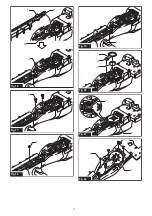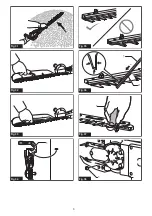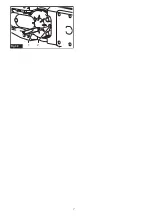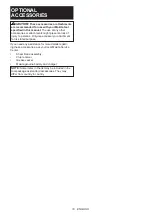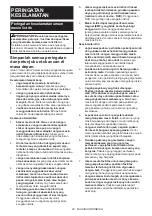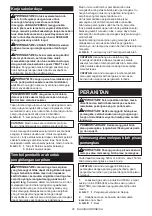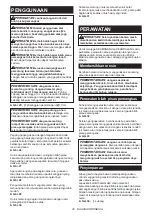
14 ENGLISH
Overheat protection for tool or
battery
There are two types of overheating; tool overheating
and battery overheating. When the tool overheating
occurs, all speed indicators blink. When the battery
overheating occurs, indicator for “1” blinks.
If the overheating occurs, the tool stops automatically.
Let the tool and/or battery cool down before turning the
tool on again.
Overdischarge protection
When the battery capacity becomes low, the tool stops
automatically and indicator for “1” blinks.
If the tool does not operate even when the switches are
operated, remove the battery from the tool and charge
the battery.
Power switch action
WARNING:
For your safety, this tool is
equipped with lever which prevents the tool from
unintended starting. NEVER use the tool if it runs
when you simply pull the switch triggers without
pressing the lever. Return the tool to our autho-
rized service center for proper repairs BEFORE
further usage.
WARNING:
NEVER tape down or defeat pur-
pose and function of the lever.
WARNING:
Before installing the battery
cartridge on the tool, always check to see that
the switch triggers and lever actuate properly
and return to the “OFF” position when released.
Operating a tool with a switch that does not actuate
properly can lead to loss of control and serious per
-
sonal injury.
CAUTION:
Never put your finger on the
switch triggers when carrying.
The tool may start
unintentionally and cause injury.
NOTICE:
Do not pull the switch trigger hard
without pressing the lever. This can cause switch
breakage.
Press the main power button to turn on the tool. The
power lamp lights up when the tool is turned on. To turn
off the tool, press and hold the main power button. The
power lamp goes off when the tool is turned off.
►
Fig.4:
1.
Power lamp
2.
Main power button
NOTE:
The tool is automatically turned off if the tool is
not operated for a certain period.
To prevent the switch trigger from being accidentally
pulled, the lever is provided. To start the tool, pull the
front switch trigger, and then pull the rear switch trigger
while pressing the lever. When you release either of the
switch triggers, the tool stops.
►
Fig.5:
1.
Lever
2.
Rear switch trigger
3.
Front switch
trigger
Reverse button for debris removal
WARNING:
If the entangled branches or
debris cannot be removed by the reverse func-
tion, switch off the tool and remove the battery
cartridge, and then remove the entangled
branches or debris using tools such as pliers.
Failure to switch off the tool and remove the bat
-
tery cartridge may result in serious personal injury
from accidental start-up. Removing the entangled
branches or debris by hand may cause an injury,
since the shear blades may move in reaction to
removing them.
This tool has a reverse button to change the direction
of shear blades movement. It is only for removing
branches and debris entangled in the tool.
To reverse the shear blades movement, press the
reverse button when the shear blades have stopped,
then pull the front switch trigger, and then pull the rear
switch trigger while pressing the lever. The power lamp
starts blinking, and the shear blades move in reverse
direction.
When entangled branches and debris are removed,
the tool returns to the regular movement and the power
lamp stops blinking and lights up.
►
Fig.6:
1.
Power lamp
2.
Reverse button
NOTE:
If the entangled branches or debris cannot be
removed, release the switch triggers, then press the
reverse button, and then pull the switch triggers until
they are removed.
NOTE:
If you tap the reverse button while the shear
blades are still moving, the tool comes to stop and to
be ready for reverse movement.
ASSEMBLY
CAUTION:
Always be sure that the tool is
switched off and the battery cartridge is removed
before carrying out any work on the tool.
CAUTION:
When replacing the shear blades,
always wear gloves so that your hands do not
directly contact the blades.
NOTICE:
When replacing the shear blades, do
not wipe off grease from the gear and crank.
Installing or removing the shear
blades
CAUTION:
Attach the blade cover before
removing or installing the shear blades.
You can install 500 mm, 600 mm or 750 mm shear
blades to your tool.
NOTE:
If you change the shear blades to a different
length, replace the chip receiver with one which fits
the blades.
Summary of Contents for DUH504S
Page 2: ...1 2 3 Fig 1 1 2 Fig 2 1 2 Fig 3 1 2 Fig 4 2 1 3 Fig 5 2 1 Fig 6 2 1 Fig 7 1 Fig 8 2 ...
Page 3: ...1 2 Fig 9 1 2 Fig 10 2 1 3 4 Fig 11 Fig 12 1 2 Fig 13 1 Fig 14 1 2 3 Fig 15 3 ...
Page 4: ...1 2 3 4 Fig 16 1 Fig 17 1 Fig 18 1 Fig 19 1 2 3 Fig 20 1 2 Fig 21 1 2 Fig 22 4 ...
Page 5: ...2 1 Fig 23 2 1 Fig 24 1 2 Fig 25 Fig 26 Fig 27 Fig 28 Fig 29 Fig 30 5 ...
Page 6: ...Fig 31 Fig 32 Fig 33 1 Fig 34 Fig 35 1 2 Fig 36 1 Fig 37 1 Fig 38 6 ...
Page 7: ...2 1 Fig 39 7 ...




